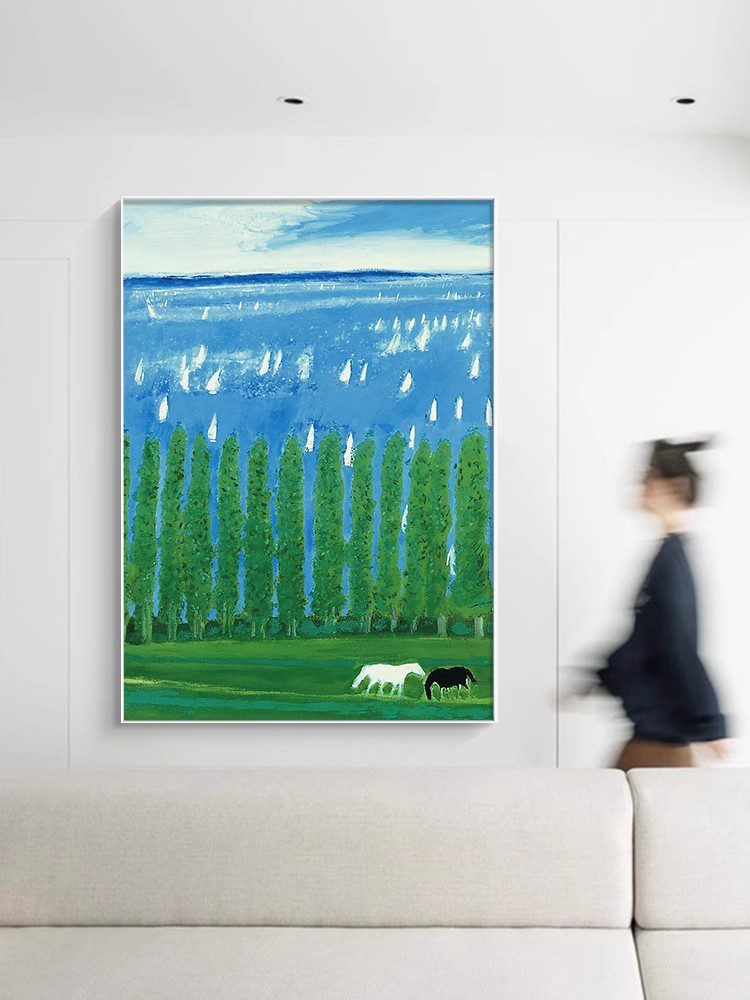How to Appreciate the Artistic Conception in Hand-Painted Oil Art: A Guide to Unlocking Emotional Depth and Imagination
Artistic conception, often translated as “yijing” in Chinese art theory, refers to the intangible atmosphere, emotion, or narrative that transcends the literal subjects of a painting. Unlike technical elements like brushwork or color, it emerges from the interplay of composition, symbolism, and emotional resonance, inviting viewers to engage with the artwork on a subjective, almost poetic level. Appreciating this aspect requires patience, observation, and an openness to interpretation. Below, explore how to decode the artistic conception in hand-painted oil art through its emotional layers, symbolic language, and the dialogue it creates between the artist and viewer.
1. Engage with the Emotional Atmosphere: From Subtle Moods to Intense Feelings
Artistic conception often manifests as an emotional undertone that shapes the viewer’s initial reaction. A painting might evoke tranquility through soft, diffused lighting and muted colors, as seen in landscapes depicting dawn or dusk. Conversely, bold contrasts of light and dark, jagged brushstrokes, or chaotic compositions can convey tension, anger, or melancholy. To appreciate this, observe how the artwork makes you feel physically and emotionally. Does the scene inspire calmness, unease, or curiosity? Note the artist’s use of color temperature (warm vs. cool tones), light intensity, and spatial openness—all of which contribute to the emotional weight. For example, a solitary figure in a vast, empty landscape might evoke loneliness or freedom, depending on the viewer’s perspective. Ask yourself: What emotions linger after viewing the painting, and how do they align with its visual elements?
2. Decode Symbolic Language: Hidden Meanings in Objects and Scenes
Many oil paintings use symbols to convey ideas or themes beyond their literal representation. Common symbols include wilting flowers (mortality), broken mirrors (shattered self-image), or birds in flight (freedom or escape). Historical or cultural contexts often influence these meanings; for instance, a white dove might symbolize peace in Western art but purity in other traditions. To uncover symbolic layers, examine recurring motifs or unusual details. Why does the artist include a seemingly insignificant object, like a withered leaf or a flickering candle? How do these elements interact with the main subject? In some cases, symbols are personal to the artist, reflecting their experiences or philosophies. Researching the artist’s background or the era in which they worked can provide clues. For example, a 20th-century painter might use abstract shapes to symbolize industrialization’s impact on nature, while a Renaissance artist could embed religious allegories into everyday scenes.
3. Explore the Interplay of Light and Shadow: Creating Mystery or Clarity
Light and shadow are powerful tools for shaping artistic conception, as they define not just form but also mood and narrative. Chiaroscuro, a technique using stark contrasts between light and dark, can create drama or intimacy, as in a portrait where the subject’s face is illuminated against a shadowy background. Soft, blended shadows might suggest a dreamlike or ethereal quality, while harsh, angular lighting could evoke harshness or conflict. Observe how light interacts with the scene: Does it feel natural or artificial? Does it highlight certain elements while obscuring others, guiding the viewer’s focus or leaving room for imagination? For example, a dimly lit interior with a single window might symbolize isolation or hope, depending on what the light reveals. Ask: How does the artist’s treatment of light and shadow shape the painting’s emotional tone and narrative ambiguity?
4. Analyze the Use of Space and Scale: From Intimacy to Grandeur
The way artists arrange space—whether crowded or sparse, vertical or horizontal—influences the painting’s conceptual depth. A large, empty canvas with a tiny figure can emphasize human insignificance in the face of nature or the cosmos, a theme common in Romantic landscapes. Conversely, a claustrophobic composition with overlapping figures might convey oppression or social tension. Scale variations can also create surreal or metaphorical effects; for instance, a giant hand cradling a tiny city could symbolize protection or control. Consider how the artist uses negative space (the empty areas around subjects) to amplify meaning. A vase of flowers against a blank wall might focus attention on their beauty, while a busy background could suggest decay or neglect. Ask: Does the spatial arrangement feel intentional, and how does it reinforce the painting’s central ideas?
5. Listen to the Unspoken Narrative: Imagining Stories Beyond the Frame
Artistic conception often leaves gaps in the narrative, encouraging viewers to fill them with their own interpretations. A painting of a woman gazing out a window might suggest longing, boredom, or contemplation, depending on her expression, the weather, or the view outside. The absence of certain details—like a missing hand or an unfinished background—can also spark curiosity. To appreciate this layer, resist the urge to seek a single “correct” interpretation. Instead, ask open-ended questions: What might have happened just before or after this moment? How do the characters’ postures or facial expressions hint at their relationships or inner lives? Some artists intentionally create ambiguity to provoke discussion or reflect the complexity of human experience. For example, a modern abstract painting might use fragmented shapes to represent the chaos of modern life, leaving viewers to derive their own meaning from the chaos.
Appreciating the artistic conception in hand-painted oil art requires a willingness to slow down, observe closely, and embrace ambiguity. By engaging with emotional atmospheres, decoding symbols, analyzing light and space, and imagining unspoken narratives, viewers can uncover the rich, layered meanings that make each painting unique. Remember that artistic conception is not a fixed concept but a dynamic dialogue between the artist’s vision and the viewer’s perception—one that evolves with each new encounter.
